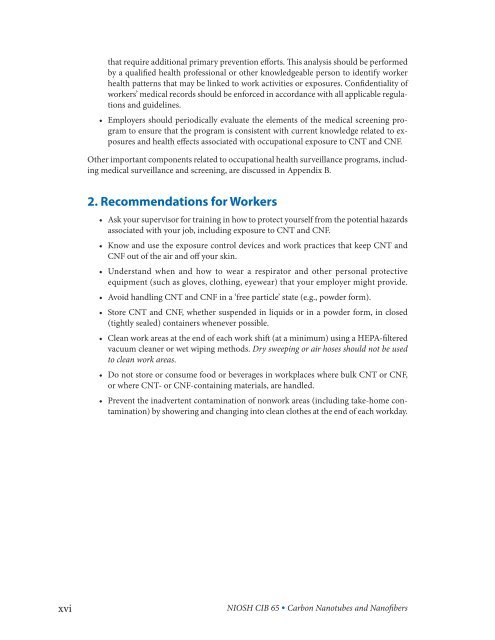Occupational Exposure to Carbon Nanotubes and Nanofibers
Occupational Exposure to Carbon Nanotubes and Nanofibers
Occupational Exposure to Carbon Nanotubes and Nanofibers
Create successful ePaper yourself
Turn your PDF publications into a flip-book with our unique Google optimized e-Paper software.
that require additional primary prevention efforts. This analysis should be performedby a qualified health professional or other knowledgeable person <strong>to</strong> identify workerhealth patterns that may be linked <strong>to</strong> work activities or exposures. Confidentiality ofworkers’ medical records should be enforced in accordance with all applicable regulations<strong>and</strong> guidelines.••Employers should periodically evaluate the elements of the medical screening program<strong>to</strong> ensure that the program is consistent with current knowledge related <strong>to</strong> exposures<strong>and</strong> health effects associated with occupational exposure <strong>to</strong> CNT <strong>and</strong> CNF.Other important components related <strong>to</strong> occupational health surveillance programs, includingmedical surveillance <strong>and</strong> screening, are discussed in Appendix B.2. Recommendations for Workers••Ask your supervisor for training in how <strong>to</strong> protect yourself from the potential hazardsassociated with your job, including exposure <strong>to</strong> CNT <strong>and</strong> CNF.••Know <strong>and</strong> use the exposure control devices <strong>and</strong> work practices that keep CNT <strong>and</strong>CNF out of the air <strong>and</strong> off your skin.••Underst<strong>and</strong> when <strong>and</strong> how <strong>to</strong> wear a respira<strong>to</strong>r <strong>and</strong> other personal protectiveequipment (such as gloves, clothing, eyewear) that your employer might provide.••Avoid h<strong>and</strong>ling CNT <strong>and</strong> CNF in a ‘free particle’ state (e.g., powder form).••S<strong>to</strong>re CNT <strong>and</strong> CNF, whether suspended in liquids or in a powder form, in closed(tightly sealed) containers whenever possible.••Clean work areas at the end of each work shift (at a minimum) using a HEPA-filteredvacuum cleaner or wet wiping methods. Dry sweeping or air hoses should not be used<strong>to</strong> clean work areas.••Do not s<strong>to</strong>re or consume food or beverages in workplaces where bulk CNT or CNF,or where CNT- or CNF-containing materials, are h<strong>and</strong>led.• • Prevent the inadvertent contamination of nonwork areas (including take-home contamination)by showering <strong>and</strong> changing in<strong>to</strong> clean clothes at the end of each workday.xviNIOSH CIB 65 • <strong>Carbon</strong> <strong>Nanotubes</strong> <strong>and</strong> <strong>Nanofibers</strong>

















